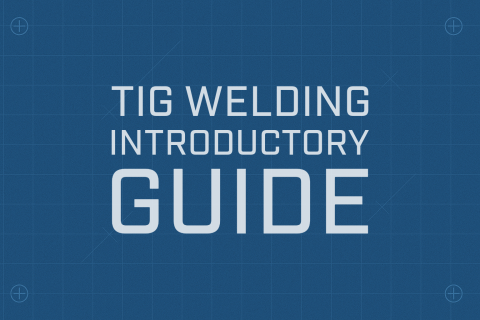TIG welding — also known as Gas Tungsten Arc Welding (GTAW) — is one of the cleanest, most precise forms of welding. Using a non-consumable tungsten electrode and an inert shielding gas (usually argon), TIG allows welders to join everything from stainless steel to aluminium with exceptional accuracy.
This guide explains how TIG welding works, why it’s used, how it compares to MIG, what equipment you’ll need, and the pros and cons of the process.
👉 Looking for the right consumables? Use our free TIG Rod Selector Tool to match filler rods to your project in seconds.
In this guide:
What is TIG Welding?
- Uses a tungsten electrode that does not melt into the weld.
- Can weld with or without filler rod.
- Relies on argon or argon-helium gas to protect the weld from contamination.
- Produces clean, strong, visually appealing welds without slag or spatter.
✅ Best for thin materials, exotic alloys, and high-quality visible welds.
How Does TIG Welding Work?
- An electrical arc forms between the tungsten electrode and the base metal.
- The heat melts the base metal, creating a weld pool.
- If needed, a filler rod is dipped into the pool while shielding gas protects the area.
- A foot pedal or fingertip control adjusts amperage in real time.
⚡ The tungsten electrode never touches the workpiece. Contamination = bad weld.
| Component | Function |
|---|---|
| Tungsten Electrode | Creates the arc (non-consumable) |
| Shielding Gas (Argon/He) | Protects molten metal from air |
| Filler Rod | Optional; adds strength/material |
| Torch & Power Source | Provides heat and arc control |
Why Choose TIG Welding?
- Precision: Fine control of heat and filler, ideal for thin materials.
- Versatility: Welds aluminium, stainless steel, nickel, copper, titanium, and more.
- Quality: Produces clean, defect-free welds with great aesthetics.
- Control: Foot pedal allows amperage adjustments on the fly.
- Flexibility: Works in all positions.
💡 TIG is especially valued in aerospace, motorsport, food/medical, and art/fabrication.
TIG vs MIG Welding
| Feature | TIG Welding (GTAW) | MIG Welding (GMAW) |
|---|---|---|
| Electrode | Non-consumable tungsten | Consumable wire electrode |
| Filler Addition | Manual (separate rod) | Automatic (wire feed) |
| Weld Quality | Very high, no spatter | Good, but more spatter |
| Learning Curve | Steeper (more skill required) | Easier for beginners |
| Speed | Slower | Faster |
| Best For | Thin/exotic metals, visible welds | General fabrication, production speed |
👉 In short: MIG is faster, TIG is cleaner.
Essential TIG Welding Equipment
| Equipment | Purpose |
|---|---|
| TIG Welder (AC/DC Inverter) | Powers the arc; AC for aluminium, DC for steels |
| Tungsten Electrodes | 2% Thoriated, Lanthanated, or Ceriated for DC; Pure or Zirconiated for AC |
| Filler Rods | Match base material (steel, stainless, aluminium, etc.) |
| Shielding Gas (Argon/Helium mix) | Protects weld pool |
| Foot Pedal or Torch Control | Adjusts amperage while welding |
| Protective Gear | Helmet, gloves, PPE — essential for UV & fume protection |
TIG Tungsten Electrode Guide
Tungsten electrodes come in different types, identified by color coding, each with its own properties. Choosing the right one is critical for arc stability, ease of starting, and weld quality.
| Electrode Type | Color Code | Current Type | Best Uses | Notes |
|---|---|---|---|---|
| Pure Tungsten (W) | Green | AC only | Aluminium, magnesium | Forms a clean balled tip. Least durable. Rarely used with modern inverters. |
| 2% Thoriated (WT20) | Red | DC | Carbon steel, stainless, nickel alloys | Easy start, stable arc, durable. Slightly radioactive — handle with care. |
| 2% Ceriated (WC20) | Grey | DC (low amps) | Thin stainless, carbon steel, orbital welding | Excellent arc starting at low amps. Good for precision, thin materials. |
| 2% Lanthanated (WL20) | Blue | AC & DC | Aluminium, stainless, carbon steel, copper | Most versatile. Strong starts, long life. A common all-rounder. |
| 1.5% Lanthanated (WL15) | Gold | AC & DC | Similar to blue electrodes, but slightly easier arc starts | Good choice for hobbyists and pros alike. |
| Zirconiated (WZr) | White | AC | Aluminium and magnesium | Resists contamination, maintains a balled tip. Excellent for high-amp AC. |
| Rare Earth / Multi-Mix | Purple | AC & DC | Wide range of materials, general purpose | Blend of oxides. Very versatile, long-lasting. Often preferred with inverter TIG machines. |
💡 Quick Tips:
- For steel/stainless → Red (Thoriated), Blue (Lanthanated), or Grey (Ceriated).
- For aluminium → Green (Pure) on older transformer sets, but Blue (Lanthanated) or Purple (Rare Earth) is best for inverters.
- Always grind tungsten lengthwise (not sideways) for arc stability.
- Keep a dedicated tungsten for each material type to avoid contamination.
Recommended Tungsten Size & Amperage for TIG Welding
| Tungsten Diameter | AC Amperage Range | DC Amperage Range | Typical Material Thickness | Notes |
|---|---|---|---|---|
| 1.0 mm (0.040″) | 10–60 A | 10–75 A | Up to ~1 mm sheet metal | Ideal for very thin stainless/aluminium, low-amp precision work. |
| 1.6 mm (1/16″) | 20–90 A | 15–150 A | 1–3 mm | Most versatile size for light fabrication and thin to medium sections. |
| 2.4 mm (3/32″) | 60–150 A | 70–200 A | 3–6 mm | Common choice for general TIG work, balances control and penetration. |
| 3.2 mm (1/8″) | 100–200 A | 150–300 A | 6–10 mm | For thicker plate and higher amperage welding. |
| 4.0 mm (5/32″) | 200–300 A | 250–400 A | 10 mm+ | Heavy-duty applications; requires high-power TIG machines. |
💡 Rules of Thumb:
- Steel & stainless: 1.6 mm or 2.4 mm tungstens cover 80% of jobs.
- Aluminium: Use slightly larger tungsten sizes than for DC steel (because AC requires more current).
- Too small tungsten = overheating, tip erosion.
- Too large tungsten = harder arc starts, less stable arc at low amps.
Advantages & Disadvantages of TIG Welding
Pros:
- Highest weld quality and appearance
- Welds almost all metals, including very thin stock
- No flux, slag, or spatter
- Filler optional — autogenous welds possible
- Welds in all positions
Cons:
- Slower than MIG or Stick
- Requires high skill level (steeper learning curve)
- Sensitive to shielding gas issues (wind makes outdoor TIG difficult)
- Equipment is more expensive
Summary
TIG welding is the gold standard for precision welding. It produces clean, strong, and aesthetically perfect welds across a wide range of metals — though at the cost of speed, ease of use, and equipment price.
- Use TIG for quality and detail (aerospace, stainless, aluminium).
- Use MIG for speed and productivity (general fabrication).
👉 Get started today with the right consumables:




